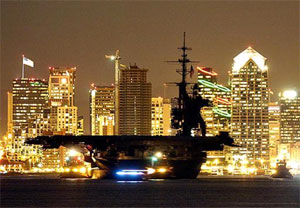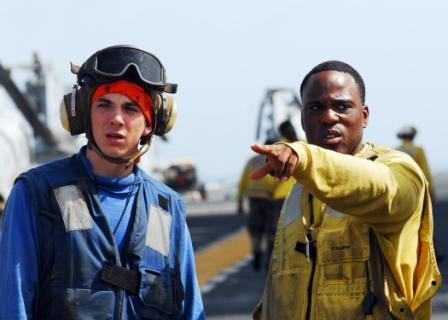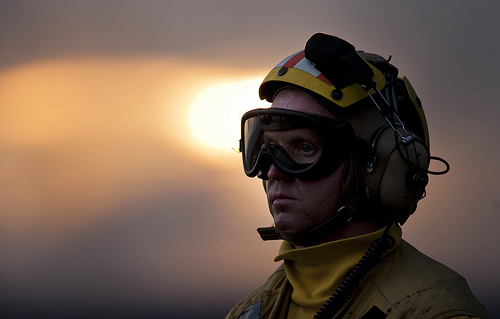Mar.03.2011
5:25 pm
by Ed Beakley
Naval Aviation 100 Years – Part 1: A Bad Night for Schoolboy – A Self-designing, High Reliability Organization
Boundary Condition #2 (2)
Of all activities studied by our research group, flight operations at sea is the closest to the “edge of the envelope”–operating under the most extreme conditions in the least stable environment, and with the greatest tension between preserving safety and reliability and attaining maximum operational efficiency. Rochlin, Laporte, Roberts
Today, one hundred years after the first naval aviator to-be checked in to begin flight training at North Island, across the San Diego Harbor resides the USS Midway (CV-41), her operational service done, she is at peace. But it was not always that way. Designed and built out of the needs of World War II, she missed that war by days. But in the Vietnam War, Midway was one of only two carriers to receive the Presidential Unit Citation, her fighter pilots were responsible for the first air-air kill of the war on 17 June 1965 and the last kill on 12 January 1973, in the Christmas bombing raids that led to the end of the war, while Air Force B-52s struck at Hanoi, CAG 5′s Intruder pilots simultaneously struck Haiphong, her attack pilots flew the last missions into North Vietnam, and she stayed on the line until the last day, the last mission of that war. The ’72 war cruise set the record for most days on the line for any carrier in the war.
Schoolboy, Midway’s call sign if you needed to talk to her in the goings and comings of “jousting with SAM and Charlie” was a warship, designed to go in harms way for the United States of America. From September 1945 to April 1992 neither Schoolboy’s crew or her airwing ever failed in that task. In the most demanding of missions, in the most demanding environment, Schoolboy owned the term reliant.
But then some days were harder than others.
To this day I can’t watch – actually hear – the scene in A Christmas Carol where Marley is about to appear to Ebinezer Scrooge on Christmas Eve without recalling that night. The junior officers of Attack Squadron 56 (VA-56) lived in two bunk rooms under the flight deck arresting gear. During flight operations the sounds of Air Wing Five’s jets dropping on to the deck, the run out of the arresting wires and the scraping reset of the cables was so routine you just hardly noticed after six months of day and night combat sorties over North Vietnam. But this was different – the nerve grinding screech was obviously something dragging across the deck that was big and out-of-place. Something was obviously very wrong. Charlie Hokansen, Ray Oswald and I were unwinding (maybe a secret Scotch in hand), having flown combat missions earlier, our day was done, or so we thought. Our other bunkroom-mate Mike “Manny” Bader was still out there, flying with our squadron commanding officer Lew Chatham. Even before “General Quarters, General Quarters, all hands man your battle stations” sounded, we three were running towards the Champ Ready Room., not just to find out what the hell was happening, but because that was our General Quarters station. What we found was not good. Almost immediately after entering the ready room, Skipper Lew followed - haggard, drenched in JP-5 jet fuel. Schoolboy and her people were in trouble. Me
Given the previous definitions of boundary conditions, this article’s purpose is two fold: First is to provide narrative of one event as part of the dynamic history of Naval Aviation- an event that comes out of personal experience, one in which I know the actors and the roles they played; Second is to use that narrative to re-introduce the idea of self designing high reliability organizations, with the carrier offered as the foremost representative. The stories of this event from various perspectives of the Air Wing Five actors are provided in PWH INTERSECTION and its sub pages:
IV. Bad Night for Schoolboy – And Other Stories of the Carrier
- 1. The Pilot’s Story: Bruce Kallsen VA-115
- 2. Landing Signal Officer Perspective
- 3. Champs In the Middle
- 4. Survival on her own terms: Midway’s Magic
You must read these stories to fully comprehend how this serious accident – one that was on the verge of catastrophic – is indeed indicative not so much of the obvious danger inherent in sea-based aviation, but rather of the ingrained “knowing what to do” of a self designing, highly reliant organization.
Communities – citizens, private companies, political leadership, first responders – don’t operate day-day in high tempo high threat environments. But those low probability, Katrina-like incidents are really low predictability,high impact, every day occurrences – somewhere. No matter the possibility, thinking the unthinkable after the fact might just indicate an avoidable error.
On a carrier at sea, different scripts call for different roles. Survival of the ship and its crew demand it. Survival when there’s no place to go is a team sport and quarterbacks change. In the case of fire, one of the most serious emergencies on a ship at sea, us college boy arrogant, God’s-gift-to-women, ne’er do well , flyboy-reason-the-ship-is-out-there, a-holes in speed jeans (anti-gravity or G- suits) report to our ready rooms so that most likely we can be assigned to a 19 year-old petty officer to man fire hoses on the flight deck - and might I importantly add, we most definitely take his direction. He knows a hell of a lot more about saving my precious than we do.
The mission of an aircraft carrier is to launch and recover combat aircraft, but its core strength is in getting past those moments when all teeters on the edge. This is the team moment, the CV moment, if you will, and in most incidents it is led and conducted not by the aviators but first by chief petty officers, and then by first, and second class petty officers. Knowledge, experience, adaptability, and an attitude derived from an understanding that this is their time, their moment.They, not the aviators are the difference makers. They know it and so do the aviators, from the Captain of the ship and the Airwing Commander down to the most fledgling aviator.
In this 100th year of Naval Aviation, Project White Horse 084640 has chosen to use the stories of naval aviation to discuss the carrier as representing a self designing highly reliant organization, and queries “what might be learned in answer to the overall question ‘what kind of an organization…’ survives and indeed thrives in crisis rich environments?”
Previously posted in Edition #6 of PWH, the findings of the research by Gene Rochlin, Todd La Porte, and Karlene Roberts are re-introduced as a extract in two parts beginning below. I encourage readers to see the Complete article.
Extract Part 1
The Self-Designing High-Reliability Organization:
Aircraft Carrier Flight Operations at Sea
By Gene I. Rochlin, Todd R. La Porte, and Karlene H. Roberts
(The complete article was originally published in the Autumn 1987 issue of Naval War College Review)
“A hundred things I have no control over could go wrong and wreck my career . . . but wherever I go from here, I’ll never have a better job than this. . . . This is the best job in the world.” Carrier commanding officer
Recent studies of large, formal organizations that perform complex, inherently hazardous, and highly technical tasks under conditions of tight coupling and severe time pressure have generally concluded that most will fail spectacularly at some point, with attendant human and social costs of great severity. The notion that accidents in these systems are “normal,” that is, to be expected given the conditions and risks of operation, appears to be as well grounded in experience as in theory. Yet there is a small group of organizations in American society that appears to succeed under trying circumstances, performing daily a number of highly complex technical tasks in which they cannot afford to “fail.” We are currently studying three unusually salient examples whereby devotion to a zero rate of error is almost matched by performance–utility grid management (Pacific Gas & Electric Company), air traffic control, and flight operations aboard U.S. Navy aircraft carriers.
Of all activities studied by our research group, flight operations at sea is the closest to the “edge of the envelope”–operating under the most extreme conditions in the least stable environment, and with the greatest tension between preserving safety and reliability and attaining maximum operational efficiency. Both electrical utilities and air traffic control emphasize the importance of long training, careful selection, task and team stability, and cumulative experience.
Yet the Navy demonstrably performs very well with a young and largely inexperienced crew, with a “management” staff of officers that turns over half its complement each year, and in a working environment that must rebuild itself from scratch approximately every eighteen months. Such performance strongly challenges our theoretical under standing of the Navy as an organization, its training and operational processes, and the problem of high-reliability organizations generally. (Emphasis added)
It will come as no surprise to this audience that the Navy has certain traditional ways of doing things that transcend specifics of missions, ships, and technology. Much of what we have to report interprets that which is “known” to naval carrier personnel, yet is seldom articulated or analyzed. We have been struck by the degree to which a set of highly unusual formal and informal rules and relationships are taken for granted, implicitly and almost unconsciously incorporated into the organizational structure of the operational Navy.
Only those who have been privileged to participate in high-tempo flight operations aboard a modern aircraft carrier at sea can appreciate the complexity, strain, and inherent hazards that underlie seemingly routine day-to-day operations. That naval personnel ultimately accept these conditions as more or less routine is yet another example of how adaptable people are to even the most difficult and stressful of circumstances….
The purpose of this article is to report some of our more relevant findings and observations to our gracious host, the Navy community; to describe air operations through the eyes of informed, yet detached observers; and to use our preliminary findings to reflect upon why carriers work as well as they do.
See Part 2 >Self-Design and Self-Replication
Or
See INTERSECTION IV. >Bad Night for Schoolboy – And Other Stories of the Carrier
At the time of publication, Professor Rochlin was adjunct professor of energy and resources and a research political scientist at the Institute of Governmental Studies, University of California, Berkeley, Professor La Porte was professor of political science and associate director of the Institute of Governmental Studies, University of California, Berkeley, and Professor Roberts, an organizational psychologist, was professor of business administration at the University of California, Berkeley.
Filed in 2011 Boundary Conditions,Fly Navy-100 Years | Comments Off



